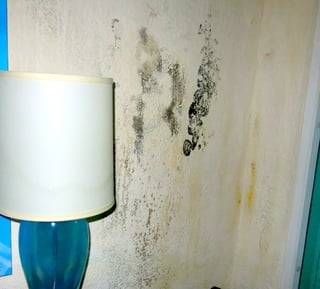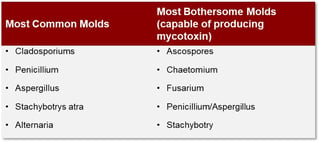Excessive growth of mold can destroy building materials and also cause health problems.
 Following a hurricane, heavy rain, or floods mold can grow on various types of materials and can often begin to grow problematically and spread within a few days. If left untreated mold can destroy the materials it is growing on as well as adjacent materials. The excessive growth of mold not only can cause damage in homes, but can also cause health problems.
Following a hurricane, heavy rain, or floods mold can grow on various types of materials and can often begin to grow problematically and spread within a few days. If left untreated mold can destroy the materials it is growing on as well as adjacent materials. The excessive growth of mold not only can cause damage in homes, but can also cause health problems.
As a fact of life, fungi, mold, and mold spores are most everywhere around us: outside of buildings, inside of buildings, in the air, and settled on surfaces. Some molds are benign and yet others have been related to certain human health related issues. Various people react differently to the presence of mold based on age, previous exposure and many other factors.
Mold requires three conditions to grow: warmth, an organic food source, and moisture.

If you are concerned, consult with professionals for medical and environmental advice. Since mold is everywhere, indoor air samples should always be compared to concurrent outdoor samples. Differences between the two samples are critical to understanding and determining the possibility of a particular mold related issue in a building.
Understanding where mold grows and how it spreads
Common places for mold growth when warmth and water are readily available, include:
- Drywall and paperfaced insulations
- Wood products, ceiling tiles, cardboard, wallpaper, carpets, fabrics
- Plants, food, decaying leaves and other organic materials
In short periods of time mold growths, or colonies, can start to excessively reproduce on damp, organic surfaces. Mold reproduces when spores - tiny, lightweight “seeds”- travel through the air and land on surfaces with food sources. Eventually mold will destroy the material that it is growing on and expands to adjacent materials as it digests these materials.
How mold occurs and how to remove it
Mold in buildings needs moisture to grow, which usually occurs from one or two sources:
- Water intrusion from the outside through walls, roofs, or windows
- Indoor moisture sources such as leaking water pipes, floods, large or numerous plants, or other water sources like aquariums and condensation
When moisture intrusion happens at, or near an exterior wall, the mold can grow in the wall cavity and damage the facing of the drywall, and the insulation.
Common wall construction consists of wood studs installed vertically with drywall on the interior side of the studs, an exterior siding or masonry system on the outside of the studs, and fiberglass or foam insulation between the studs.
When moisture gets into this wall "cavity", the result may be mold on the inside paper facing of the drywall or insulation. Often, the mold growing on the drywall will become apparent on the interior side of the wall, especially at the floor or ceilings.
When the growth of mold on drywall and insulation goes untreated, direct implications to homes can include:
- The continued spread of mold
- Damaged, deteriorating, or rotting walls materials
- Health issues such as respiratory problems, skin irritations, or nose, eye, and throat irritations
Therefore, it is important that mold and moisture be removed as soon as possible. EPA suggests a 24 to 48 hour period for the removal of moisture will normally prevent the spread of mold. Remediation of mold growth on drywall in wall cavities may require that the wall cavity be exposed to air by removing and disposing of the drywall and all other affected materials, then treating the remaining materials. Often removing the bottom two feet of drywall, with dehumidification on and blowers, is sufficient.
Mold contaminated material is not regulated and can be disposed of as regular waste. In order to prevent the spread of mold to non-affected areas in a building, contaminated material should be removed from the work area in a sealed disposal bag or wrapped in plastic.
Once the contaminated materials are removed, then the wall cavity can be cleaned and dried. Rigid insulation that has been contaminated can be cleaned and dried and does not necessarily need to be disposed of, depending on the extent of the mold growth.
What to do if you think there’s a presence of mold
If you believe there is a presence of mold in your property you should contact the insurance provider to set up an inspection and contact qualified professionals famliar with required regulations for workers. CCA can also help assist with the investigation and remediation of mold in your property.



